Student Learning Science: Developing a Science Unit for Primary School
VerifiedAdded on 2023/03/31
|6
|1152
|104
Project
AI Summary
This assignment focuses on developing a science unit for primary school students, specifically centered around building a school vegetable garden. The project encompasses the creation of a unit of work alongside a rationale that critically examines the unit's implementation. The assignment delves into the role of assessment (diagnostic, formative, and summative) in meeting student learning needs. It also addresses potential issues for both learners and teachers, such as resource availability, diverse student abilities, and health and safety concerns, proposing strategies to mitigate these challenges. Furthermore, the assignment explores improvements and adaptations to extend the unit's learning potential, including long-term planning, data recording, and incorporating seasonal considerations. The student's work provides a comprehensive overview of creating and refining a practical science learning resource for primary school education.
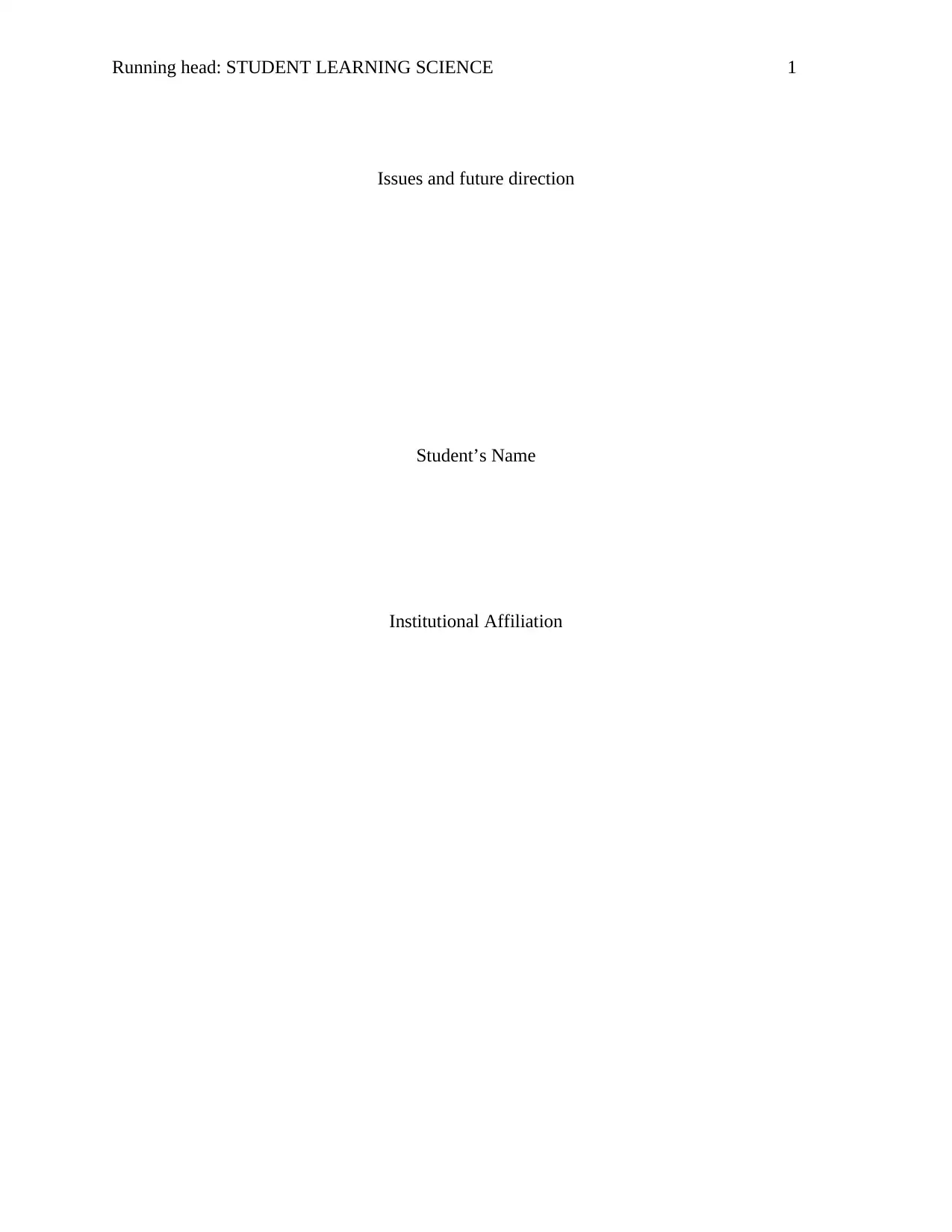
Running head: STUDENT LEARNING SCIENCE 1
Issues and future direction
Student’s Name
Institutional Affiliation
Issues and future direction
Student’s Name
Institutional Affiliation
Paraphrase This Document
Need a fresh take? Get an instant paraphrase of this document with our AI Paraphraser
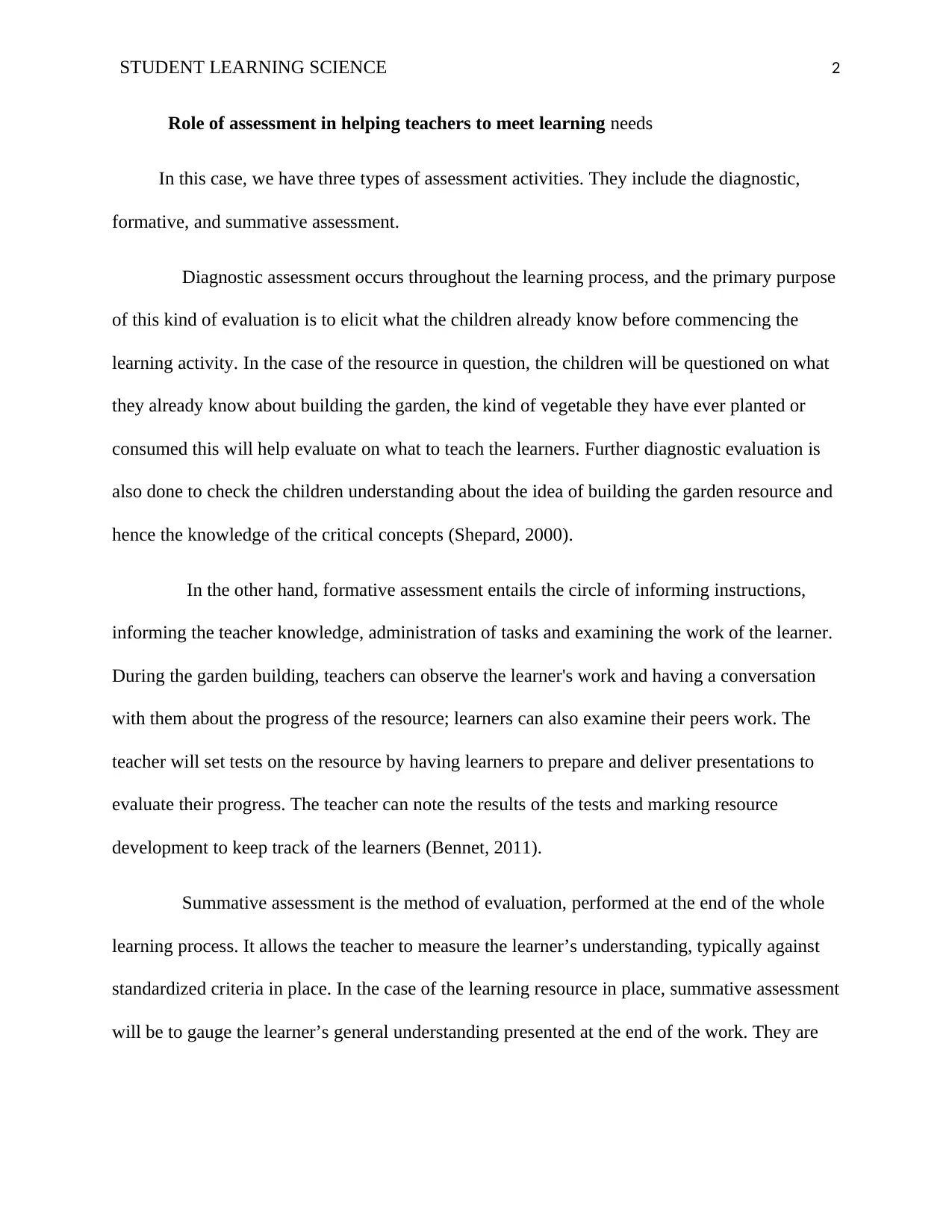
STUDENT LEARNING SCIENCE 2
Role of assessment in helping teachers to meet learning needs
In this case, we have three types of assessment activities. They include the diagnostic,
formative, and summative assessment.
Diagnostic assessment occurs throughout the learning process, and the primary purpose
of this kind of evaluation is to elicit what the children already know before commencing the
learning activity. In the case of the resource in question, the children will be questioned on what
they already know about building the garden, the kind of vegetable they have ever planted or
consumed this will help evaluate on what to teach the learners. Further diagnostic evaluation is
also done to check the children understanding about the idea of building the garden resource and
hence the knowledge of the critical concepts (Shepard, 2000).
In the other hand, formative assessment entails the circle of informing instructions,
informing the teacher knowledge, administration of tasks and examining the work of the learner.
During the garden building, teachers can observe the learner's work and having a conversation
with them about the progress of the resource; learners can also examine their peers work. The
teacher will set tests on the resource by having learners to prepare and deliver presentations to
evaluate their progress. The teacher can note the results of the tests and marking resource
development to keep track of the learners (Bennet, 2011).
Summative assessment is the method of evaluation, performed at the end of the whole
learning process. It allows the teacher to measure the learner’s understanding, typically against
standardized criteria in place. In the case of the learning resource in place, summative assessment
will be to gauge the learner’s general understanding presented at the end of the work. They are
Role of assessment in helping teachers to meet learning needs
In this case, we have three types of assessment activities. They include the diagnostic,
formative, and summative assessment.
Diagnostic assessment occurs throughout the learning process, and the primary purpose
of this kind of evaluation is to elicit what the children already know before commencing the
learning activity. In the case of the resource in question, the children will be questioned on what
they already know about building the garden, the kind of vegetable they have ever planted or
consumed this will help evaluate on what to teach the learners. Further diagnostic evaluation is
also done to check the children understanding about the idea of building the garden resource and
hence the knowledge of the critical concepts (Shepard, 2000).
In the other hand, formative assessment entails the circle of informing instructions,
informing the teacher knowledge, administration of tasks and examining the work of the learner.
During the garden building, teachers can observe the learner's work and having a conversation
with them about the progress of the resource; learners can also examine their peers work. The
teacher will set tests on the resource by having learners to prepare and deliver presentations to
evaluate their progress. The teacher can note the results of the tests and marking resource
development to keep track of the learners (Bennet, 2011).
Summative assessment is the method of evaluation, performed at the end of the whole
learning process. It allows the teacher to measure the learner’s understanding, typically against
standardized criteria in place. In the case of the learning resource in place, summative assessment
will be to gauge the learner’s general understanding presented at the end of the work. They are
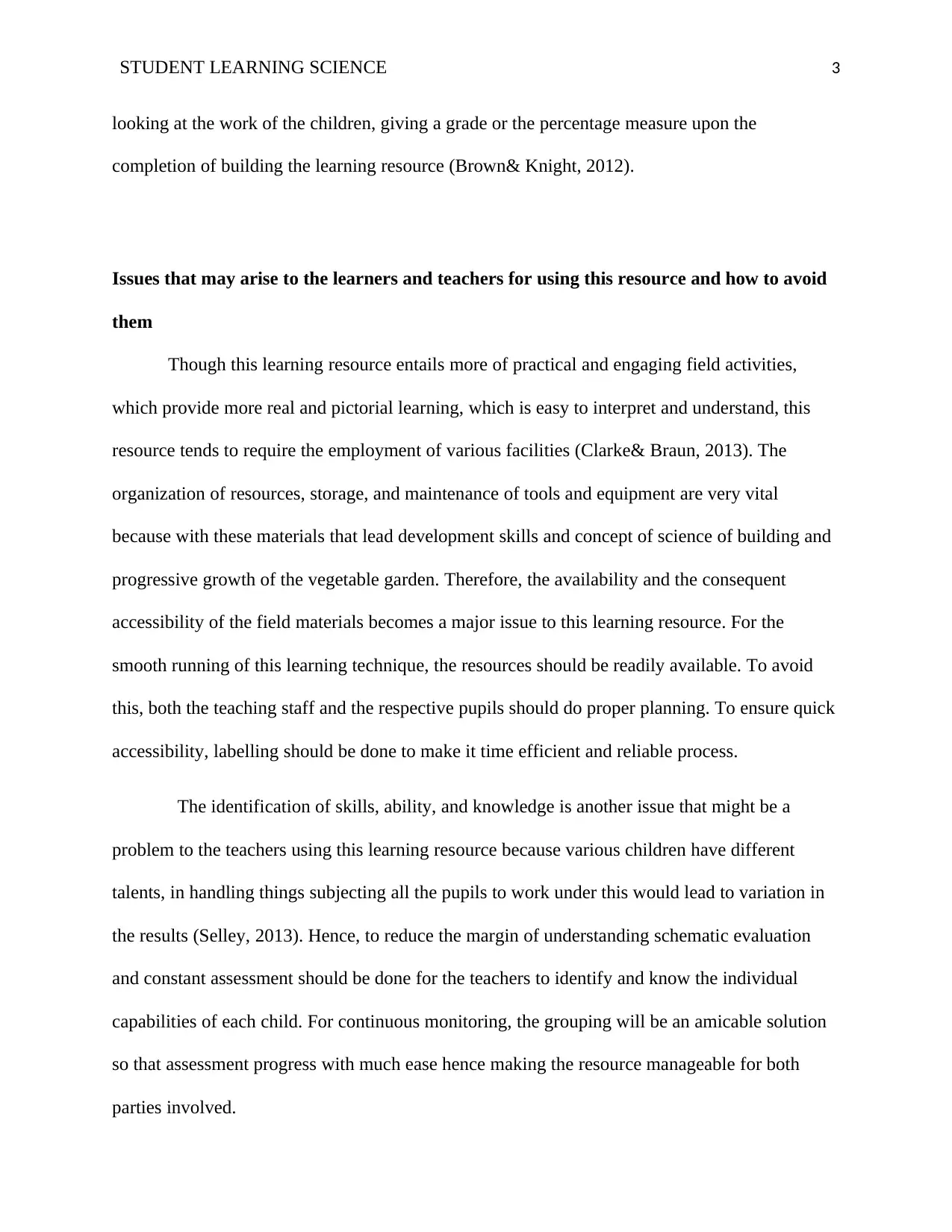
STUDENT LEARNING SCIENCE 3
looking at the work of the children, giving a grade or the percentage measure upon the
completion of building the learning resource (Brown& Knight, 2012).
Issues that may arise to the learners and teachers for using this resource and how to avoid
them
Though this learning resource entails more of practical and engaging field activities,
which provide more real and pictorial learning, which is easy to interpret and understand, this
resource tends to require the employment of various facilities (Clarke& Braun, 2013). The
organization of resources, storage, and maintenance of tools and equipment are very vital
because with these materials that lead development skills and concept of science of building and
progressive growth of the vegetable garden. Therefore, the availability and the consequent
accessibility of the field materials becomes a major issue to this learning resource. For the
smooth running of this learning technique, the resources should be readily available. To avoid
this, both the teaching staff and the respective pupils should do proper planning. To ensure quick
accessibility, labelling should be done to make it time efficient and reliable process.
The identification of skills, ability, and knowledge is another issue that might be a
problem to the teachers using this learning resource because various children have different
talents, in handling things subjecting all the pupils to work under this would lead to variation in
the results (Selley, 2013). Hence, to reduce the margin of understanding schematic evaluation
and constant assessment should be done for the teachers to identify and know the individual
capabilities of each child. For continuous monitoring, the grouping will be an amicable solution
so that assessment progress with much ease hence making the resource manageable for both
parties involved.
looking at the work of the children, giving a grade or the percentage measure upon the
completion of building the learning resource (Brown& Knight, 2012).
Issues that may arise to the learners and teachers for using this resource and how to avoid
them
Though this learning resource entails more of practical and engaging field activities,
which provide more real and pictorial learning, which is easy to interpret and understand, this
resource tends to require the employment of various facilities (Clarke& Braun, 2013). The
organization of resources, storage, and maintenance of tools and equipment are very vital
because with these materials that lead development skills and concept of science of building and
progressive growth of the vegetable garden. Therefore, the availability and the consequent
accessibility of the field materials becomes a major issue to this learning resource. For the
smooth running of this learning technique, the resources should be readily available. To avoid
this, both the teaching staff and the respective pupils should do proper planning. To ensure quick
accessibility, labelling should be done to make it time efficient and reliable process.
The identification of skills, ability, and knowledge is another issue that might be a
problem to the teachers using this learning resource because various children have different
talents, in handling things subjecting all the pupils to work under this would lead to variation in
the results (Selley, 2013). Hence, to reduce the margin of understanding schematic evaluation
and constant assessment should be done for the teachers to identify and know the individual
capabilities of each child. For continuous monitoring, the grouping will be an amicable solution
so that assessment progress with much ease hence making the resource manageable for both
parties involved.
⊘ This is a preview!⊘
Do you want full access?
Subscribe today to unlock all pages.

Trusted by 1+ million students worldwide

STUDENT LEARNING SCIENCE 4
Unlike the classroom set up where learning takes place in an enclosed environment, this
resource is done outdoors hence health, safety, and the hygiene factors become a primary
concern. The exposure of teachers and learners to the adverse weather conditions is deemed
risky. In addition, the vegetables to be grown are subject to change in weather and thus prove
more unreliable than the classroom-learning scheme. To address this issue, proper scheduling
should be done. Such the learning is conducted during proper periods reducing the risk factors
that are imposed to the learner and the learning resource.
In conclusion, to avoid facing issues, it is important to note that when seeking to develop
quality investigative learning resource, it is then vital that the resources are readily available to
the learners. A wide range of requirements should support this.
1. The Improvement to extend the potential of the learning resource
Learning is a continuous process, which entails well-planned topics and chapter to
follow. This is well achieved in the case of the classroom context. Classroom learning and
planning is always easier and is the most reliable context employs in studies. The garden
resource can be utilized to be a long term potential means by embracing the adaptable measure to
ensure that this resource does not only last for a season but to be a continuous, reliable process
(Bell, 2014). This will be achieved by putting up seasonal plans for the resource, to last long as
the whole year through the learning period. This can be done by detailing the seasons and getting
the knowledge of what can be grown and at what season and having an attainable plan such that
Unlike the classroom set up where learning takes place in an enclosed environment, this
resource is done outdoors hence health, safety, and the hygiene factors become a primary
concern. The exposure of teachers and learners to the adverse weather conditions is deemed
risky. In addition, the vegetables to be grown are subject to change in weather and thus prove
more unreliable than the classroom-learning scheme. To address this issue, proper scheduling
should be done. Such the learning is conducted during proper periods reducing the risk factors
that are imposed to the learner and the learning resource.
In conclusion, to avoid facing issues, it is important to note that when seeking to develop
quality investigative learning resource, it is then vital that the resources are readily available to
the learners. A wide range of requirements should support this.
1. The Improvement to extend the potential of the learning resource
Learning is a continuous process, which entails well-planned topics and chapter to
follow. This is well achieved in the case of the classroom context. Classroom learning and
planning is always easier and is the most reliable context employs in studies. The garden
resource can be utilized to be a long term potential means by embracing the adaptable measure to
ensure that this resource does not only last for a season but to be a continuous, reliable process
(Bell, 2014). This will be achieved by putting up seasonal plans for the resource, to last long as
the whole year through the learning period. This can be done by detailing the seasons and getting
the knowledge of what can be grown and at what season and having an attainable plan such that
Paraphrase This Document
Need a fresh take? Get an instant paraphrase of this document with our AI Paraphraser
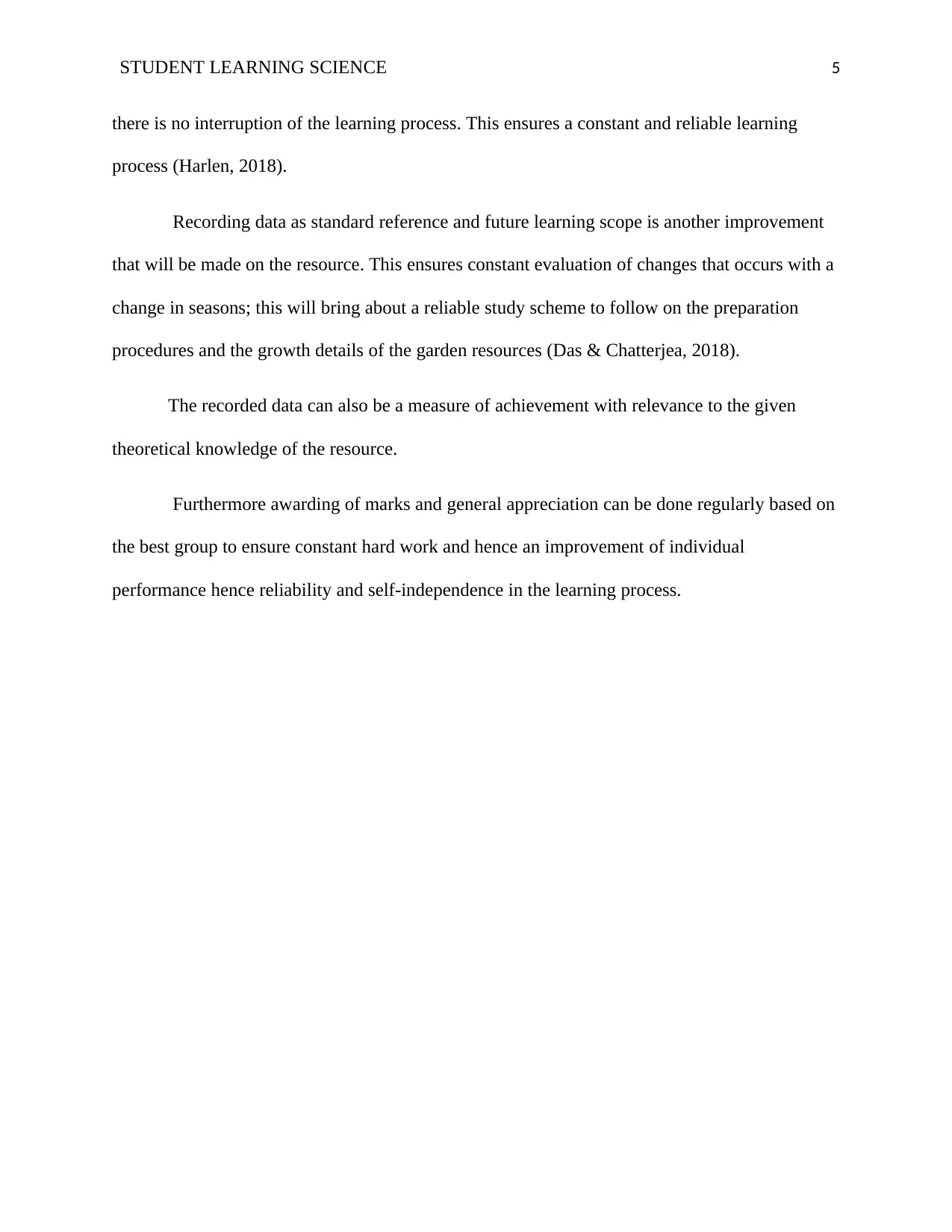
STUDENT LEARNING SCIENCE 5
there is no interruption of the learning process. This ensures a constant and reliable learning
process (Harlen, 2018).
Recording data as standard reference and future learning scope is another improvement
that will be made on the resource. This ensures constant evaluation of changes that occurs with a
change in seasons; this will bring about a reliable study scheme to follow on the preparation
procedures and the growth details of the garden resources (Das & Chatterjea, 2018).
The recorded data can also be a measure of achievement with relevance to the given
theoretical knowledge of the resource.
Furthermore awarding of marks and general appreciation can be done regularly based on
the best group to ensure constant hard work and hence an improvement of individual
performance hence reliability and self-independence in the learning process.
there is no interruption of the learning process. This ensures a constant and reliable learning
process (Harlen, 2018).
Recording data as standard reference and future learning scope is another improvement
that will be made on the resource. This ensures constant evaluation of changes that occurs with a
change in seasons; this will bring about a reliable study scheme to follow on the preparation
procedures and the growth details of the garden resources (Das & Chatterjea, 2018).
The recorded data can also be a measure of achievement with relevance to the given
theoretical knowledge of the resource.
Furthermore awarding of marks and general appreciation can be done regularly based on
the best group to ensure constant hard work and hence an improvement of individual
performance hence reliability and self-independence in the learning process.
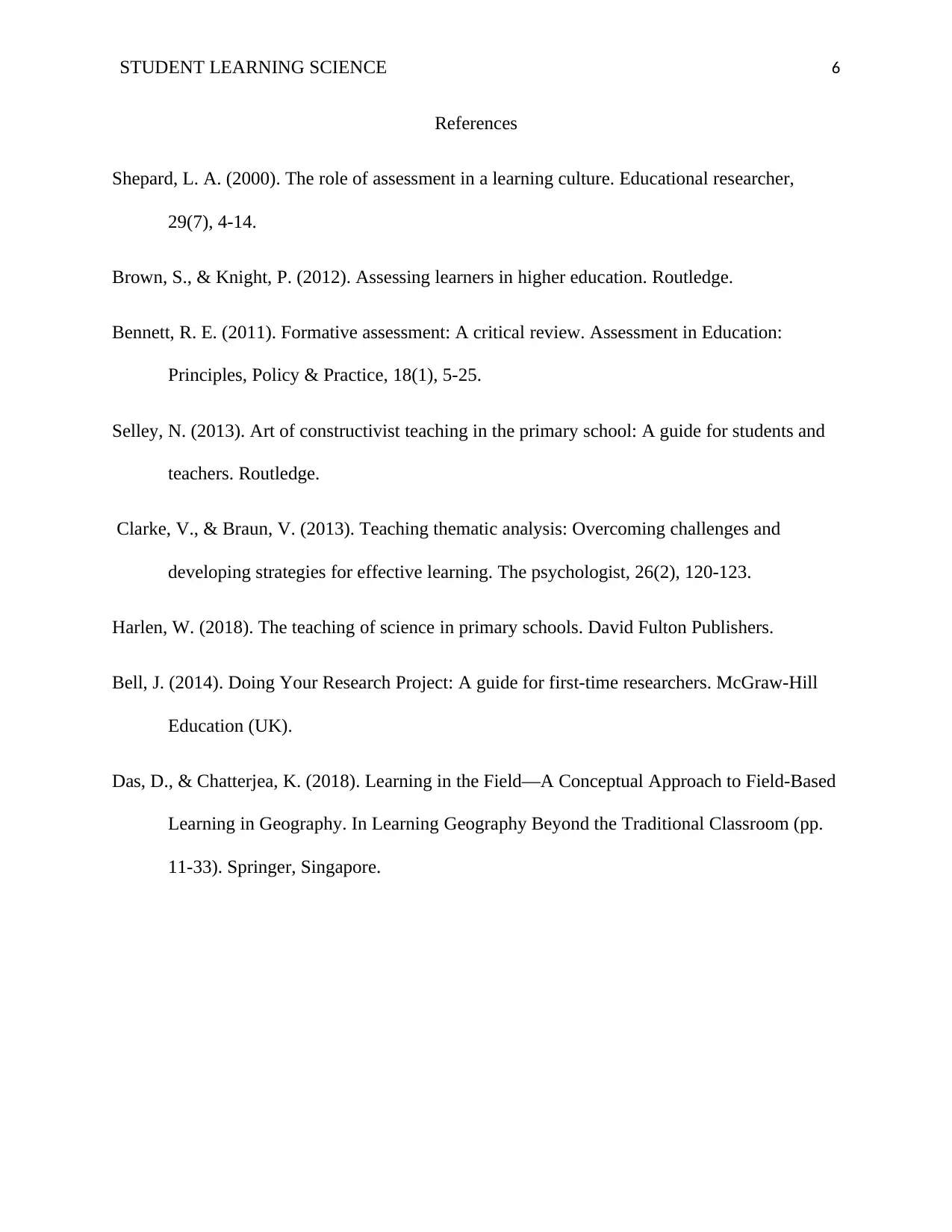
STUDENT LEARNING SCIENCE 6
References
Shepard, L. A. (2000). The role of assessment in a learning culture. Educational researcher,
29(7), 4-14.
Brown, S., & Knight, P. (2012). Assessing learners in higher education. Routledge.
Bennett, R. E. (2011). Formative assessment: A critical review. Assessment in Education:
Principles, Policy & Practice, 18(1), 5-25.
Selley, N. (2013). Art of constructivist teaching in the primary school: A guide for students and
teachers. Routledge.
Clarke, V., & Braun, V. (2013). Teaching thematic analysis: Overcoming challenges and
developing strategies for effective learning. The psychologist, 26(2), 120-123.
Harlen, W. (2018). The teaching of science in primary schools. David Fulton Publishers.
Bell, J. (2014). Doing Your Research Project: A guide for first-time researchers. McGraw-Hill
Education (UK).
Das, D., & Chatterjea, K. (2018). Learning in the Field—A Conceptual Approach to Field-Based
Learning in Geography. In Learning Geography Beyond the Traditional Classroom (pp.
11-33). Springer, Singapore.
References
Shepard, L. A. (2000). The role of assessment in a learning culture. Educational researcher,
29(7), 4-14.
Brown, S., & Knight, P. (2012). Assessing learners in higher education. Routledge.
Bennett, R. E. (2011). Formative assessment: A critical review. Assessment in Education:
Principles, Policy & Practice, 18(1), 5-25.
Selley, N. (2013). Art of constructivist teaching in the primary school: A guide for students and
teachers. Routledge.
Clarke, V., & Braun, V. (2013). Teaching thematic analysis: Overcoming challenges and
developing strategies for effective learning. The psychologist, 26(2), 120-123.
Harlen, W. (2018). The teaching of science in primary schools. David Fulton Publishers.
Bell, J. (2014). Doing Your Research Project: A guide for first-time researchers. McGraw-Hill
Education (UK).
Das, D., & Chatterjea, K. (2018). Learning in the Field—A Conceptual Approach to Field-Based
Learning in Geography. In Learning Geography Beyond the Traditional Classroom (pp.
11-33). Springer, Singapore.
⊘ This is a preview!⊘
Do you want full access?
Subscribe today to unlock all pages.

Trusted by 1+ million students worldwide
1 out of 6
Related Documents
Your All-in-One AI-Powered Toolkit for Academic Success.
+13062052269
info@desklib.com
Available 24*7 on WhatsApp / Email
![[object Object]](/_next/static/media/star-bottom.7253800d.svg)
Unlock your academic potential
Copyright © 2020–2025 A2Z Services. All Rights Reserved. Developed and managed by ZUCOL.



